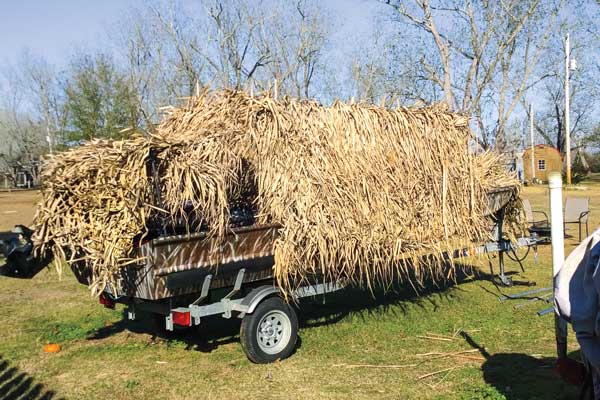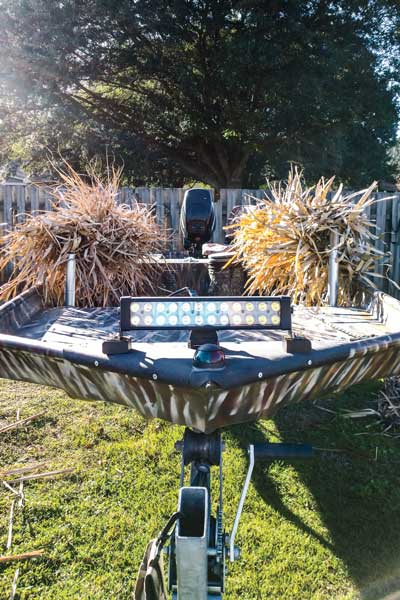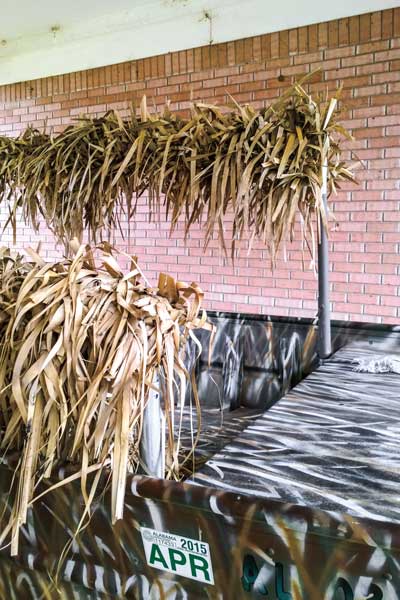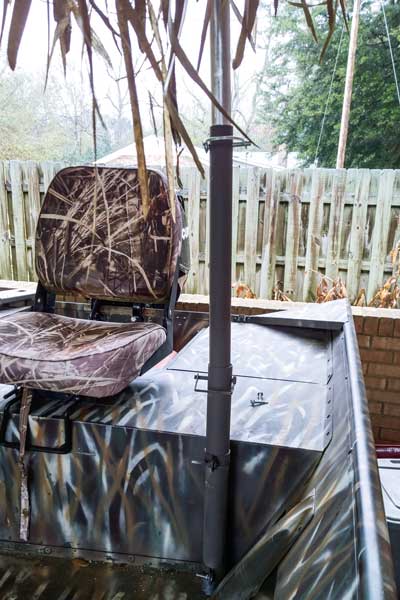May 06, 2015
By Mike Marsh
 Ryan Gipson's first hunt was for woodies with his dad. Just six or seven at the time, he fell in love with the birds. Gipson, who resides in Robertsdale, Ala., mainly shoots gadwalls, redheads, bluebills and buffleheads in Mobile Bay, but still chases a few wood ducks on the Upper Delta.
Ryan Gipson's first hunt was for woodies with his dad. Just six or seven at the time, he fell in love with the birds. Gipson, who resides in Robertsdale, Ala., mainly shoots gadwalls, redheads, bluebills and buffleheads in Mobile Bay, but still chases a few wood ducks on the Upper Delta.
"Mobile Bay is a tidal salt marsh and the Upper Delta is mostly flooded hardwoods," said Gipson, a 2014 B&B contest honorable mention. "From where I launch to where I set up in the bay is about a 10-minute boat ride, and it takes us about two minutes to set up my blind."
Gipson began looking for a better way to hunt ducks after an unpleasant experience on Mobile. He was hunting out of a 15-foot Gheenoe when the boat almost sank.
" After hunting a few hours and bagging four or five ducks, we decided to call it a day," he said. "The wind had gotten a little stronger and was now blowing out of the west. The bay was white-capping and the water was coming over the sides. After both of us moved to the back of the boat to raise the bow, we somehow managed to make it back to the launch."
Advertisement
Who's The Boss
On the old Gheenoe, Gipson had built a blind from some wire shelving. After months of debate with his wife about hunting more safely and hours of looking over used boats online every night, he finally found one that would fit his budget.
 "Last summer, I purchased a 1648 Alumacraft that had all the makings for a great duck boat," he said.
"Last summer, I purchased a 1648 Alumacraft that had all the makings for a great duck boat," he said.
Advertisement
Gipson wanted a nice blind to go with the best boat he ever owned. However, the standard pop-up blinds he found cost between $350 and $600.
"No way could I talk the boss lady into letting me spend that," he said. "I had several ideas for blinds, but one kept sticking in my head."
The blind Gipson designed and built fit all of his criteria at a cost of only $150. While we have seen dozens of different pop-ups for johnboats, his telescoping design was unique.
The blind consists of 1½-inch EMT for the bottom section of each leg, 1¼-inch EMT pipe for the middle section and 11/8-inch chain-link fence post pipe for the top section. Each section slides into the other. The sections are held in place by clip pins inserted through holes drilled through them. The necessary pipes come in 10-foot lengths.
"This blind can be modified to fit any boat," he said. "First, you cut each size of the pipe into four 18-inch sections and keep the excess for making cross-members. Cut the sections to allow up to 2 inches of the pipe to project into the corresponding lower section to provide extra support when the blind is erect. The four different leg systems are grouped together and a 5/16-inch hole drilled through the tops of each of the pipes to receive the clip pins.
"This is best achieved by using a drill press to keep the holes' alignments straight and true through the corresponding sections. The goal is to insert a 5/16-inch clip pin through the holes to keep the sections erect, but with as little play as possible."
Superior Support
Once all four leg assemblies are clipped together they should be as straight as possible. Each leg assembly will move around a bit while it is freestanding, but will tighten up once the top poles of the blind have been attached.
At the bottom of each leg assembly, Gipson installed a metal self-tapping screw, but he said a pin or bolt would work also. These screws are about 1½ inches from the base and keep the center section from falling all the way down inside the bottom section when the blind is lowered.
 Next, Gipson installed eight 1½-inch conduit hangers in the boat. He said that any type of fastener could be used to attach them to the sides of the aluminum boat seats, but he recommended using rubber expansion well nuts because they secure everything tightly, yet allow the blind to be removed easily at the end of the season. Two clamps are required to hold each leg assembly in place. The paired clamps must be perfectly aligned from top to bottom so the blind will slide up and down properly.
Next, Gipson installed eight 1½-inch conduit hangers in the boat. He said that any type of fastener could be used to attach them to the sides of the aluminum boat seats, but he recommended using rubber expansion well nuts because they secure everything tightly, yet allow the blind to be removed easily at the end of the season. Two clamps are required to hold each leg assembly in place. The paired clamps must be perfectly aligned from top to bottom so the blind will slide up and down properly.
"I installed a 90-degree chain-link fence corner connector at the top of each leg assembly and screwed a self-tapping screw through it into the 11/8-inch top pipe. On my boat, the length of the opening was roughly eight feet, so I cut two pieces of 11/8-inch pipe to that length and secured them into the 90-degree connectors. Before tightening them all the way, I checked the top piece to make sure it was level. If it is not, just cut one of the top leg sections. I used another self-tapping screw to attach the corner connector to the top rail."
Using the leftover pieces of 11/8-inch pipe, Gipson made two cross-members for the fore and aft ends at the top of the blind. He secured these to the tops of the blind's side rails with 5/16-inch clip pins. When he transports the blind, he removes one pin and the other pin becomes a pivot point so the front and back cross-members rotate out of the way, along the side rails.
 The base layer of camouflage material consists of grass mats, which Gipson secured to the frame with zip ties. Gipson zip-tied a full-length piece of ¾-inch PVC pipe to the bottom of the mats to keep them weighted when they fall outside of the boat while the blind is deployed for hunting. He rolls the grass mats around the PVC for transport and storage and keeps them in place with Bungee cords. When he erects the blind and unrolls the mats, they cover the engine, bow and gunwales.
The base layer of camouflage material consists of grass mats, which Gipson secured to the frame with zip ties. Gipson zip-tied a full-length piece of ¾-inch PVC pipe to the bottom of the mats to keep them weighted when they fall outside of the boat while the blind is deployed for hunting. He rolls the grass mats around the PVC for transport and storage and keeps them in place with Bungee cords. When he erects the blind and unrolls the mats, they cover the engine, bow and gunwales.
"Ducks don't care how much you spend on your rig," Gipson said. "We'd all probably be better off just sticking to the basics."
Materials List
1 10-foot length of 1½-inch EMT pipe
1 10-foot length of 1¼-inch EMT pipe
3 10-foot lengths of 1 1/8-inch chain-link fence post pipe
8 1½-inch EMT conduit hangers
12 5/16 x 2¾-inch clip pins
4 1 1/8-inch chain-link fence 90-degree connectors
Self-tapping screws and clip pins or other connection hardware

